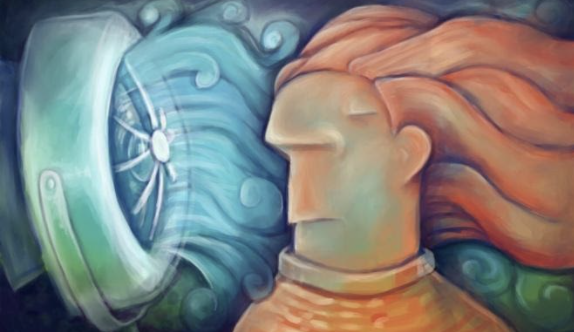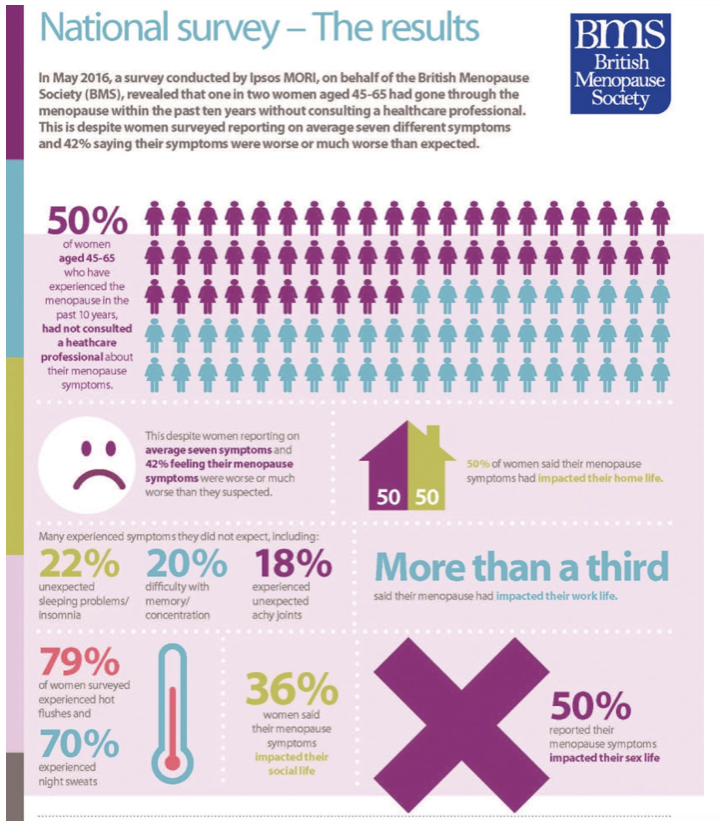Menopause – an introduction
What is the menopause?
The menopause marks the end of menstruation in a woman’s life. A woman has reached menopause when she has not had a period for one year. The menopause is a natural part of ageing and usually occurs between the ages of 45-55 years. The time leading up to menopause, menopausal transition is called the perimenopause.
Oestrogen is a hormone mainly produced in the ovaries and plays a key role in the female reproductive system. It also has other functions – it protects bone health and affects your brain, heart, skin and other tissues. During the perimenopause, your ovaries start to produce less oestrogen As a result, there are many changes that can occur to the body. The brain, skin, muscles and emotions are all affected by falling levels of oestrogen. The symptoms we associate with the menopause are thought to be due to declining oestrogen levels. There are over 30 symptoms associated with the menopause.

Common symptoms associated with the menopause:
Hot flushes
Sleep disturbances
Joint and muscle aches and pains
Mood disturbance
Reduced sex drive
Vaginal dryness and painful intercourse
Irregular periods
Thinning hair and dry skin
The symptoms often start several months or years before the menopause but are different for every woman. Not all women experience symptoms and symptoms vary in severity and how long they last.
What is a hot flush?
A hot flush is often described as a sudden feeling of heat which seem to come from nowhere and spread upwards through the body, the chest, neck and face. Some women also suffer from palpitations, sweating and facial flushing at the same time. The hot flushes usually only last 2-4 minutes. Some women only have occasional hot flushes that do not really bother them, while others can have many a day and find them uncomfortable, disruptive and embarrassing.
Although they are not life-threatening, they can affect our quality of life, disrupt sleep, cause irritability and mood disturbances and interfere with our work or social life.
Hot flushes often start a few months or years before the menopause and typically resolve within 2-6 years.
What are the risks of the menopause?
After the menopause, when the ovaries stop producing oestrogen there can be a long-term effect on the bones and heart which make you more vulnerable to:
- Heart disease and stroke. Ask your doctor for advice on how to protect your heart, such as how to reduce your cholesterol or blood pressure if it’s too high.
- Osteoporosis. This condition causes bones to become brittle and weak, leading to an increased risk of fractures. Postmenopausal women with osteoporosis are especially susceptible to fractures of their spine, hips and wrists.
- Weight gain. Many women gain weight during the menopausal transition and after menopause.
How is the menopause treated?
Maintaining good overall emotional and physical health is an important aspect of coping with menopause and its symptoms including hot flushes.
Every woman is different and the severity of their menopause symptoms also varies from woman to woman. There are many effective treatments available, from lifestyle adjustments to hormone therapy.
Lifestyle adjustments may help reduce mild-to-moderate menopause symptoms. You may wish to try the following strategies:
- Keeping cool: Dress in loose, layered clothing made of natural fibres. You can then remove a layer if you get too hot. Keep your room cool and use a fan as necessary.
- Try to pinpoint what triggers your hot flushes. You may be able to manage your symptoms by reducing caffeine and alcohol intake and cutting back on spicy food.
- Improve sleep by keeping your bedroom cool, avoiding caffeine and alcohol in the evening and exercising earlier in the day. Practice relaxation and breathing techniques.
- Vaginal lubricants can help manage vaginal dryness and painful intercourse.
- Strengthen your pelvic floor. Pelvic floor muscle exercises, called Kegel exercises, can improve some forms of urinary incontinence.
- Eat a healthy balanced diet. Include a variety of fruits, vegetables and whole grains. Limit saturated fats, oils and sugars to reduce the risk of heart disease and weight gain. There is some evidence that eating phytoestrogens such as flaxseed, soy, edamame, pumpkin seeds and chickpeas, over a prolonged time can help with mild hot flushes.
- For bone health, ensure you are eating enough calcium-rich foods, are maintaining adequate vitamin D levels by being out in the sunshine. Ask your doctor if you need calcium or vitamin D supplements to help meet daily requirements.
- Smoking cessation. Smoking increases your risk of heart disease, stroke, osteoporosis, cancer and a range of other health problems. It may also increase hot flushes and bring on earlier menopause.
- Exercise regularly. Regular physical activity or exercise helps protect against heart disease, type 2 diabetes, osteoporosis and other conditions associated with ageing. It can also help reduce stress and improve mood.
- Talk to your family members and friends about feelings of anxiety and mood changes so that they know your needs.
If your symptoms are more severe and are interfering with your day to day life despite these tips then make an appointment with your doctor to discuss possible pharmacological treatments. These may include:
- Hormone therapy (HRT). Oestrogen therapy is the most effective treatment option for relieving menopausal hot flashes. Oestrogen also helps prevent bone loss. Long-term use of hormone therapy may have some cardiovascular and breast cancer risks, but starting hormones around the time of menopause has shown benefits for many women. Discuss the benefits and risks of hormone therapy with your doctor and whether it’s a safe choice for you.
- Vaginal oestrogen. To relieve vaginal dryness, oestrogen can be administered directly to the vagina using a vaginal cream, tablet or ring. This treatment releases just a small amount of oestrogen, which is absorbed by the vaginal tissues.
- If you are unable to take oestrogen for health reasons your doctor can talk to you about nonhormonal medications. These may include antidepressants, gabapentin and clonidine.
- Depending on individual needs, your doctor may recommend medication to prevent or treat osteoporosis. Several medications are available that help reduce bone loss and risk of fractures.
Talk with your doctor about your options and the risks and benefits involved with each. Review your options yearly, as your needs and treatment options may change.
By Dr Mohgah Elsheikh

For more information go to; https://thebms.org.uk/publications/tools-for-clinicians/
 Dr Mohgah Elsheikh MBBCh, FRCP
Dr Mohgah Elsheikh MBBCh, FRCP



